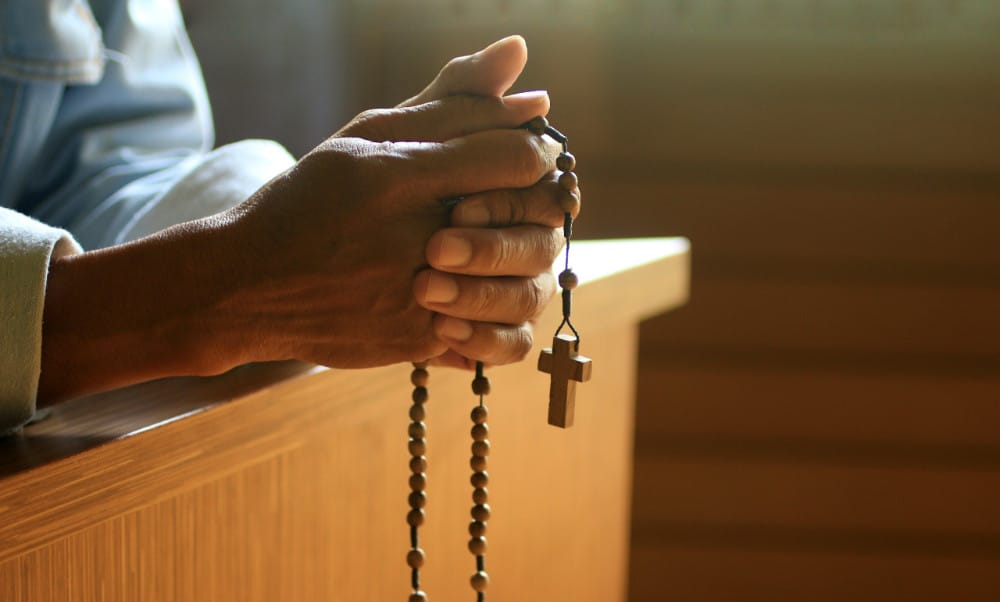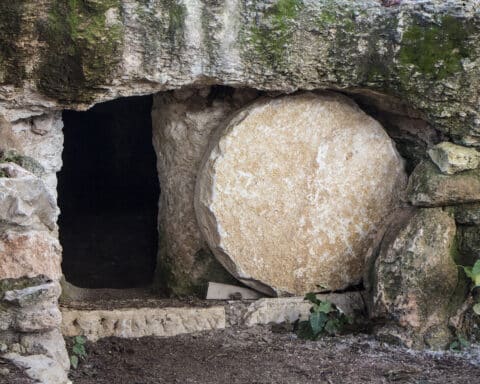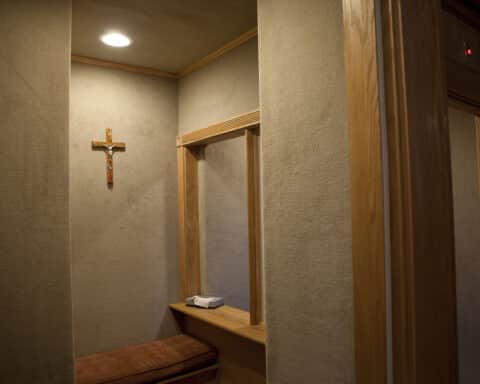On Aug. 14, the vigil of the solemnity of the Assumption of the Blessed Virgin Mary, The Atlantic published an article originally titled, “How the Rosary Became an Extremist Symbol.” Now titled “How Extremist Gun Culture Is Trying to Co-Opt the Rosary,” the piece was first accompanied by an image of a rosary made up of bullet holes, which has also been subsequently modified. In the provocative piece, the author, Daniel Panneton, argues that, on an extremist fringe, “rosary beads have been woven into a conspiratorial politics and absolutist gun culture.”
Panneton writes that “radical-traditional Catholics sustain their own cottage industry of goods and services that reinforces the radicalization.” The Atlantic contributor objects to gun-metal finish crucifixes and replicas of the “combat rosaries” given to soldiers fighting in World War I. For Panneton, these symbols “work to integrate ultraconservative Catholicism with other aspects of online far-right culture.”
Martial imagery, it is true, is found in Scripture, and from the first century, martial language has been used as a principal analogy for how Christians view prayer. In the New Testament, St. Paul writes: “Put on the armor of God so that you may be able to stand firm against the tactics of the devil. For our struggle is not with flesh and blood but with the principalities, with the powers, with the world rulers of this present darkness, with the evil spirits in the heavens” (Eph 6:11-12). But in the Scriptures the military analogy is always used in reference to the spiritual battle, and never against other human beings, as Panneton implies. Paul goes on to refer to the “shield of faith,” “the helmet of salvation” and “the sword of the Spirit.” Rightly then do Padre Pio, John Paul II and Mother Teresa all call the Rosary a weapon, but one only wielded in spiritual combat.
But despite the article’s catechetical shortcomings (the first subheading referred to the Rosary as a sacrament!), we should heed his caution about ways in which our tradition can be subverted by movements antithetical to Church teaching. Indeed, perhaps the most uncomfortable point of the article for Catholics lies within its partial correctness. There are indeed extremists — members of the so-called “alt-right” — who have adopted traditional Catholic imagery to try to pull faithful Catholics in a radical political direction. Despite the fact that most of the leaders of the alt-right proudly proclaim themselves atheists or pagans, they feel no compunction in co-opting Catholic symbols when it serves their political purposes. Alternatively aggressive and cajoling, they have targeted faithful Catholics, especially on social media, with political appeals wrapped in Catholic imagery — including, yes, the Rosary.
Interestingly, Panneton seems unaware of this concerted effort and tries instead to imply that there’s something about Catholicism itself that has led to the phenomenon he describes. (At yet another point in the history of Panneton’s article, it bore the title “How Rad-Trad Catholics Weaponized the Rosary.”)
Panneton also fails to acknowledge that members of the alt-right have taken advantage of the real political violence churches and pro-life centers have suffered to try to convince Catholics that violence is therefore justified on their side. Panneton raises the specter of Christian violence, but the reality he misses is that those who have been trying to pull Christians in this direction have ample examples of violence against Christian churches and ministries to point to.
As we have previously written, violence against Catholic churches in America is on the rise. The USCCB reports, “At least 160 incidents have occurred across 37 states and the District of Columbia since May 2020.” These attacks “include arson, statues beheaded, limbs cut, smashed and painted, gravestones defaced with swastikas and anti-Catholic language and American flags next to them burned, and other destruction and vandalism.” Catholic institutions have invested in security plans, additional policing, cameras and myriad other means of protection in the wake of this considerable wave of violence.
We must stand firm in the face of grave evils, such as attempts to redefine marriage or expand the availability of abortion, but we must never endorse or further our causes with actual violence, or even with language that suggests a spirit of violence. Martial language in the Christian tradition promotes discipline, strength, steadfastness, courage against the spiritual powers that “prowl about the world, seeking the ruin of souls.” It must be preserved. However, St. Paul also taught the Ephesians, “All bitterness, fury, anger, shouting, and reviling must be removed from you, along with all malice” (Eph 4:31).
To hesitate to condemn that which lies beyond the pale wounds the integrity of tradition, rather than preserves it. As the ancient medical analogy goes, when a limb becomes gangrenous, it must be cut off to preserve the body. While we are right to object to the ways that The Atlantic mischaracterized the Faith — indeed, these must be corrected — so, too, must we be clear about condemning those who would adapt our sacred prayers and symbols for their own nefarious purposes.
Our Sunday Visitor Editorial Board: Gretchen R. Crowe, Scott P. Richert, Scott Warden, York Young





